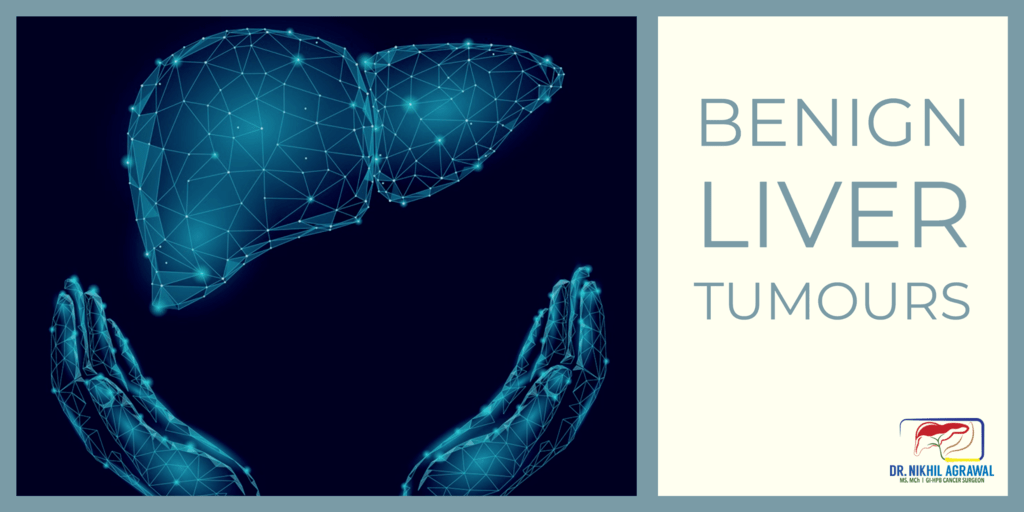Liver tumours

The liver
The liver is made up of cells called hepatocytes. There are several other specialized cells in the liver. Besides these cells, bile ducts and blood vessels criss-cross across the liver. These structures are made up of several types of cells. Any of these cells can become diseased, resulting in the formation of a tumour, cancer or cyst.
Our body has mechanisms to keep growth and division of cells under control. A tumour is formed when a normal cell gets the capacity to continuously divide and grow. This results in the formation of a mass. It could be cancerous (malignant) or non-cancerous (benign). What separates them is the ability of the cells from these tumours to spread beyond their organ of origin. A cancerous tumour will spread and non-cancerous will not. Besides these tumours, several types of cysts can also form in the liver.
Liver cancers
Liver cancer can start in the liver or come to the liver from other organs. The one which starts in the liver is primary liver cancer. Cancer which spreads to the liver from other organs is secondary liver cancer or metastatic cancer. Learn more about them here.
Liver cysts
A cyst is a fluid-filled structure surrounded by a wall or membrane. Several types of cysts occur in the liver. These include simple cyst, polycystic liver disease, hydatid cyst, liver abscesses, cystadenoma of the liver, various cystic tumours and Caroli's disease. Learn about them here.
Benign liver tumours
Benign liver tumours are more frequent than liver cancers. They usually remain benign and rarely turn cancerous. Most do not cause any symptoms. They are commonly detected when an imaging test (ultrasound, CT or MRI) is done for evaluation of a symptom of some other disease. When a lesion is detected like this (incidentally), it is called an “incidentaloma”. The widespread use of imaging modalities has resulted in an increasing number of these lesions being diagnosed. Sometimes they cause symptoms, can have complications or can turn cancerous.
Some common benign liver tumours include hemangioma, focal nodular hyperplasia and hepatocellular adenoma.
Hemangioma
Hemangioma is a tumour of blood vessels and most common benign liver tumour. It is a mass of abnormal blood vessels. It is a common tumour and occurs in 1-5% of adults. There can be many hemangiomas in 10% of cases. Hemangiomas over 5 cm are called giant hemangiomas. Hemangiomas are usually asymptomatic. They can cause symptoms when large. Their diagnosis is confirmed on contrast-enhanced CT and/or MRI. complications such as rupture can sometimes occur with these tumours. Some atypical hemangiomas can be difficult to differentiate from other liver tumours.
Surgical resection of hemangioma is required if:
- If it is causing symptoms
- When it is large and at risk of rupture
- When it is rapidly enlarging
Focal nodular hyperplasia
Focal nodular hyperplasia is the second most common form of benign liver tumour after hemangiomas. It contains a scar in the centre. It occurs more commonly in women from their second to the fourth decade. It can be multifocal in 10-20%. It never becomes cancerous and usually does not increase in size. Spontaneous rupture and bleeding also do not occur. They can occasionally cause symptoms.
Hepatocellular adenoma
It is a tumour of hepatocytes. It occurs primarily in young women. Intake of oral contraceptive pills and pregnancy is a risk factor for the occurrence of this tumour. Those that are related to oral contraceptive use will usually regress after stopping it. It can occasionally become cancerous. These tumours may rupture and bleed into the abdominal cavity. Sometimes they are multiple (>10), a condition called adenomatosis. Surgical resection is required when it is on the surface of the liver and at risk of rupture and when the size is more than 5 cm. Certain subtypes are more at risk of cancerous transformation and should be resected.
Other less common benign liver tumours
- Angiomyolipoma
- Hepatic lipoma
- Mesenchymal hamartoma
- Benign biliary hamartoma (bile duct adenoma, biliary adenofibroma and Von Meyenberg complex)
Signs and symptoms
The majority of these patients do not have any symptoms and the lesion is detected on an imaging test (ultrasound, CT or MRI) done for unrelated reasons. Even when symptoms are present, we should ensure that the symptom is related to liver lesions and not something else.
Symptoms when present can include:
- Abdominal pain
- Abdominal discomfort
- Feeling of fullness
- Nausea or vomiting
- Loss of appetite
- Early satiety
Diagnosis
Treatment of benign liver lesion depends on symptoms, size and type of lesion. It's important to identify the type of lesion. Tests help to diagnose and differentiate one tumour from another. Tests are also required to follow them if we choose to observe them, and most of them require only observation.
Blood tests: Complete blood count measures the distinct cells in the blood. Liver and kidney function tests assess the function of these organs. A liver function test is usually normal. Blood clotting tests will show whether the liver is making enough of them. The blood test will also check for hepatitis B and C.
Tumour markers: A blood test will also look for tumour markers. Tumour markers are elevated in malignant tumours and help differentiate benign tumours from malignant.
Ultrasound: It is a basic investigation to look inside your abdomen and usually the first investigation which detects the mass in the liver. It uses sound waves which bounce off the internal organs and creates a picture of them on the computer monitor.
Computed tomography scan (CT scan): In this, the patient is placed in a scanner and beams of X-rays scan the abdomen from all sides. These images are then computer-processed, giving an accurate representation of inside organs. For liver lesions, triple-phase CT helps us determine the type of lesion. In this, the images are enhanced with contrast by injecting it into the blood circulation and scanning is done in phases while the contrast passes through the liver. The CT scan gives information about the size and location of tumours in the liver. It also shows the relation of cancer to blue duct and blood vessels in the liver.
Magnetic resonance imaging (MRI): It is a test similar to a CT scan. Instead of X-Ray, strong magnetic fields and radio waves are used to take images. MRI is a useful modality to distinguish types of liver tumours. MR images are also enhanced with liver-specific contrast agents, acquiring images in phases.
Biopsy: Biopsy means sampling a small piece of the tumour and examining it under a microscope. Biopsy of a liver lesion is done under ultrasound or CT guidance. A biopsy is not always needed for the diagnosis of liver lesion. We require it only when the diagnosis is uncertain based on imaging studies.
Treatment
Treatment of these lesions depends on symptoms, type of tumour, size and complications. In patients who are experiencing symptoms or are facing some complications of the tumour, the approach is generally straightforward. Surgical resection is indicated in such patients.
In asymptomatic patients, the approach is more nuanced. Determining the type of liver tumour required and need multiple imaging modalities. Sometimes a biopsy will also be required to ascertain the type of lesion.
Surgery for liver tumours
Surgical resection is indicated in patients with complication and symptoms. Surgical removal is also done in patients where the likelihood of complications or cancerous transformation is high. Some patients would require surgery because the workup will fail to distinguish benign from malignant tumours.
Surgery for liver tumour involves the removal of the tumour-bearing part of the liver.
Hepatectomy or liver resection
Hepatectomy is the removal of part of the liver containing cancer with healthy margins. It is done when the remaining liver after surgery is of adequate size and functioning well. The remaining liver grows over a few weeks. With advancements in surgical technique, we do this procedure laparoscopically in selected patients.
Laparoscopic liver resection
Open surgery uses a long incision over the abdomen for the surgery. The laparoscopic approach uses minimally invasive techniques to do the same surgery with tiny incisions. This entails the insertion of special long thin surgical tools through these small holes. Laparoscopic liver resection results in faster recovery and reduced pain compared to conventional open surgery.
Wish you a speedy recovery!


